Historical Roots of Plant Magic in Britain
The mystical relationship between plants, herbs, and the people of Britain is woven deeply into the fabric of the nation’s folklore and magical superstitions. From time immemorial, the British Isles have been home to a rich tapestry of traditions that draw upon the power of nature’s flora. The earliest roots of this connection can be traced back to Celtic tribes, whose reverence for the natural world is well documented in ancient lore. Druids, the spiritual leaders among the Celts, regarded trees such as the oak, rowan, and yew as sacred, using their leaves and bark in rites meant to invoke protection, healing, or foresight.
As Anglo-Saxon culture spread across Britain, these early beliefs were interwoven with new customs and herbal wisdom. The Anglo-Saxon “Leechbooks”—medieval medical texts—combine practical remedies with incantations and charms that reflect a worldview where plants were not only physical cures but spiritual guardians against evil and misfortune. In medieval times, Christian influence layered further complexity onto these traditions; churchyards were often planted with protective yews, while saints’ days became associated with gathering specific herbs believed to hold heightened magical potency.
Thus, through centuries of cultural exchange and adaptation, plant magic in Britain evolved into a blend of Celtic animism, Anglo-Saxon herbalism, and medieval superstition. Whether whispered over bunches of vervain at Midsummer or tucked sprigs of rosemary under pillows for dreams free from nightmares, these practices reveal a longstanding belief in the profound power that grows quietly within Britain’s hedgerows and gardens.
2. Common Magical Plants and Their Traditional Uses
Throughout the ages, the British countryside has yielded a wealth of plants and herbs believed to hold potent magical properties. These natural treasures were not only valued for their medicinal qualities but also revered as protectors, charms, and essential tools in folk magic. Below, we explore several key British plants—rowan, elder, yarrow, and foxglove—and uncover their reputed mystical attributes and traditional uses in local superstitions.
| Plant | Magical Properties | Traditional Applications |
|---|---|---|
| Rowan | Protection from evil; warding off witches | Branches placed above doorways or worn as amulets; berries threaded into necklaces to safeguard travellers |
| Elder | Connection to the spirit world; healing and transformation | Elderflowers brewed in teas for health; sticks used in ritual wands; wood avoided for burning due to superstition |
| Yarrow | Divination; love magic; physical healing | Leaves carried to attract love or courage; flowers used in divination rituals; applied to wounds to staunch bleeding |
| Foxglove | Fairy protection; invoking visions; cautionary symbol | Planted near homes for fairy blessings (with care); leaves historically used in folk remedies, though highly toxic |
The Rowan Tree: Guardian of Hearth and Home
The rowan tree, with its distinctive red berries, is steeped in folklore as a powerful guardian against enchantment and ill fortune. In many rural communities, sprigs of rowan would be nailed above doors or stable entrances to repel negative energies. It was common practice to weave its twigs into small crosses or wear them secretly as charms during long journeys.
Elder: A Bridge Between Worlds
The elder tree carries an air of mystery, often associated with the boundary between this world and the next. According to tradition, elder was both respected and feared—its flowers were used in healing teas, while its wood was rarely burnt for fear of inviting misfortune. Ritual objects crafted from elder were believed to enhance communication with spirits or ancestors.
Yarrow: The Herb of Love and Prophecy
Yarrow’s feathery foliage made it a favourite among wise women and healers. It was prized for its ability to stop bleeding but also held fame as a tool for divining future lovers or outcomes. Placing yarrow under one’s pillow was said to inspire prophetic dreams—a custom cherished by young people hoping for glimpses of their fate.
Foxglove: Beauty and Danger Intertwined
Foxglove presents a paradox: its bell-like blossoms were linked to fairies (sometimes called “fairy gloves”), yet its potent toxicity was widely acknowledged. While some believed planting foxglove invited fairy protection, others warned that disturbing these plants could provoke mischief. Its presence serves as a reminder of nature’s dual capacity for enchantment and caution within British magical tradition.

3. Gardens, Woodlands, and Sacred Spaces
Throughout the tapestry of British magical superstitions, the natural world has long been revered as a source of power, protection, and enchantment. It is not only the individual plants and herbs themselves that have been held in esteem, but also the very places in which they grow. In the British countryside, certain environments—gardens, woodlands, and sacred spaces—have been imbued with a spiritual significance, serving as thresholds between the ordinary and the mystical.
The Sacred Grove: Ancient Seats of Power
In ancient Britain, sacred groves were often regarded as the dwelling places of spirits, deities, or ancestral forces. These secluded clusters of venerable trees were sites where Druids and wise folk might gather to perform rituals or seek wisdom from the natural world. Oaks, yews, and ash trees, in particular, were considered especially potent within these groves. Even in later centuries, the memory of these hallowed spaces persisted in local lore, with certain woods believed to offer protection against evil or to amplify the efficacy of spells.
Hedge Rows: Boundaries and Guardians
Hedge rows—those quintessentially British features winding through the countryside—have played a unique role in magical superstition. More than just practical boundaries for fields and homes, hedge rows were seen as liminal spaces: neither entirely wild nor wholly tamed. They were believed to house faeries, spirits, and magical herbs. Hawthorn, elder, and blackthorn bushes within these hedges were particularly respected for their protective qualities. It was common for villagers to plant or preserve certain shrubs to ward off malevolent forces or bring luck to the household.
Home Gardens: Enchantment on the Doorstep
The British cottage garden is steeped in tradition—not only as a place for beauty and sustenance but as a living charm. Herbs such as rosemary, lavender, and rue were often grown near doorways or windows, their aromatic presence thought to repel evil influences and attract blessings. To this day, some families maintain the custom of planting specific herbs for protection or prosperity, echoing the practices of their ancestors. The arrangement and care of these gardens became a quiet ritual, infusing daily life with subtle enchantment.
Spaces as Spiritual Connectors
Across the British Isles, these natural environments—sacred groves, hedge rows, and home gardens—have functioned not merely as backdrops for magical belief but as active participants in the weaving of superstition. Each setting provides a stage where the visible and invisible worlds might touch, offering those who tend and respect these places a sense of connection to something greater. In the gentle shade of the woodland, beside the whispering hedge, or within the fragrant cottage garden, generations have found both solace and mystery, trusting that nature herself holds the keys to protection and enchantment.
4. Protection, Healing, and Charm-making
In the rich tradition of British magical superstition, plants and herbs have long been valued not only for their practical medicinal uses but also for their perceived mystical properties. Many households, from rustic cottages to stately manors, relied upon a repertoire of botanical lore to safeguard the home, encourage wellness, and attract good fortune. Below is an exploration of how these natural allies were believed to serve in protection, healing, and the crafting of charms or talismans.
Herbs for Protection Against Evil
Across Britain, certain herbs were widely carried or hung in doorways to ward off malicious spirits, witches, or ill luck. Rowan branches, with their vibrant red berries, were especially esteemed in the north and Scotland as a guardian against enchantment. Similarly, sprigs of rue or elder hung above thresholds were thought to repel negativity and evil intent.
| Herb | Protective Use | Region/Tradition |
|---|---|---|
| Rowan | Tied above doors; worn as a cross | Scotland, Northern England |
| Elder | Branches placed in windows | Widespread |
| Rue | Worn on the person; placed at entryways | Southern England |
Healing with Herbal Remedies
The boundary between folk medicine and magic was often blurred. Herbs such as sage, mugwort, and comfrey were commonly used not just for physical ailments but also with ritualistic intent—sometimes accompanied by spoken charms or prayers. The act of gathering these plants at auspicious times (such as dawn on midsummer’s day) was believed to enhance their potency.
Examples of Healing Practices
- Sage was brewed into teas for sore throats while simultaneously blessing the drinker with wisdom and clarity.
- Mugwort was placed under pillows to ward off nightmares and promote restful sleep.
- Comfrey leaves were bound to wounds but also carried as a general talisman for safe travels.
Charm-making and Talismanic Use
The creation of charms was a cherished aspect of British magical custom. Small pouches filled with dried herbs—such as lavender for love or vervain for protection—were sewn together and kept close to the body or hidden within clothing. In some villages, it was customary to weave herb bundles into intricate knots or patterns, thought to entrap harmful influences before they could reach the household.
Common Herbal Charms
| Charm Type | Main Ingredients | Purpose |
|---|---|---|
| Love Sachet | Lavender, Rose Petals | Attract affection |
| Protection Bundle | Mugwort, Rowan Berries | Avert evil spirits |
| Luck Pouch | Clover, Heather | Invite good fortune |
The enduring reverence for these botanical traditions speaks to a uniquely British appreciation of nature’s subtle powers—a blend of practicality and enchantment that still echoes in modern folk practices today.
5. Herbs in Rituals and Seasonal Celebrations
Throughout the British Isles, the cyclical rhythm of rural life has long been marked by a tapestry of seasonal festivals and local customs, many of which entwine the use of plants and herbs with magical intention. The ancient festival of Beltane, heralding the arrival of summer on the first of May, is a prime example. Traditionally, villagers would weave hawthorn branches into garlands or crown maypoles, believing this tree to be a potent protector against evil spirits and a bringer of fertility to both land and livestock. Herbs such as rowan and elder were also hung above doorways or carried as amulets to safeguard homes and hearts during this liminal time.
As autumn’s shadows lengthen, Samhain arrives—a festival that marks the turning of the year and honours ancestors. During Samhain, bundles of mugwort or sage might be burned to purify spaces and guide wandering souls safely. Rosemary, too, would be scattered or worn for remembrance, its aromatic presence believed to strengthen the link between the living and those who have passed beyond.
Beyond these well-known celebrations, countless regional folk rituals wove plants into their proceedings. In Cornwall, rushes were laid on church paths at Lammas, while in Yorkshire, ‘guisers’ might carry sprigs of holly for protection during winter revels. Even simple acts—such as tucking a sprig of lavender under a pillow for peaceful dreams—reflected a deep-rooted trust in nature’s cycles.
Through such rites, plants and herbs became more than mere adornment; they embodied continuity, hope, and connection to the land. Their presence in seasonal rituals reveals not only an enduring respect for nature’s gifts but also the way in which British magical superstitions have anchored communities within the eternal turning of the year.
6. Contemporary Practices and Revival
In present-day Britain, the age-old traditions entwined with magical herbs have neither faded nor been consigned to the annals of history. Rather, they have experienced a gentle revival, finding new expressions in modern folklore, witchcraft, and the burgeoning field of herbalism. Many contemporary practitioners, whether identifying as witches, folk healers, or simply enthusiasts of natural living, draw inspiration from the ancient lore that once shaped village customs and household rites across the British Isles.
British witchcraft—often termed as the Old Craft or Traditional Witchcraft—continues to honour native plants such as rowan, yarrow, and elder. These botanicals are gathered during auspicious times, much as they were by ancestors who believed in the protective and divinatory powers of flora. In particular, rowan branches are still fashioned into charms against ill luck, while mugwort finds favour among those seeking to enhance psychic awareness during rituals or dream work.
The recent resurgence of interest in herbalism has further invigorated these traditions. Today’s herbalists may reference both scientific knowledge and folk wisdom, blending remedies that echo those found in medieval herbals and seventeenth-century cunning-folk practices. Public workshops, community gardens, and herbal walks often incorporate storytelling, linking participants to the mythic qualities of plants such as nettle for courage or hawthorn for love and protection.
Modern British folklore also plays its part in this revival. Festivals and seasonal celebrations—such as May Day or Samhain—are increasingly marked by rituals involving native herbs and flowers, reflecting an enduring respect for nature’s cycles. It is not uncommon to see garlands of wildflowers adorning doorways or hear tales of the bluebell woods’ enchantments retold with a fresh appreciation for their ancient origins.
In summary, the magical superstitions surrounding British plants and herbs have not only survived but flourished anew in contemporary culture. Whether through ritual, remedy, or storytelling, these traditions persist as living threads connecting modern Britons to their landscape, heritage, and a sense of wonder that transcends time.


